Suede is a delicate material that often causes confusion: can suede get wet? What are some tips for cleaning and caring for suede? How do I protect my suede shoes from the rain? In this article, we will answer all of those questions and more. So, whether you’re wondering if it’s safe to wear your suede shoes in the rain or how to clean a stain off your favorite jacket, read on for our ultimate guide to taking care of your suede!
What is Suede Leather?
Leather is undoubtedly a luxurious material, and it has been used to make all kinds of products, from clothing to furniture. Suede leather is a type of leather that is made from the innermost layer of skin, also known as the split hide. This leather is very soft and has a napped finish, which gives it a velvet-like feel. It is softer and more pliable than top-grain leather, making it suitable for clothing and other garments. Suede is also less expensive than full-grain leather.
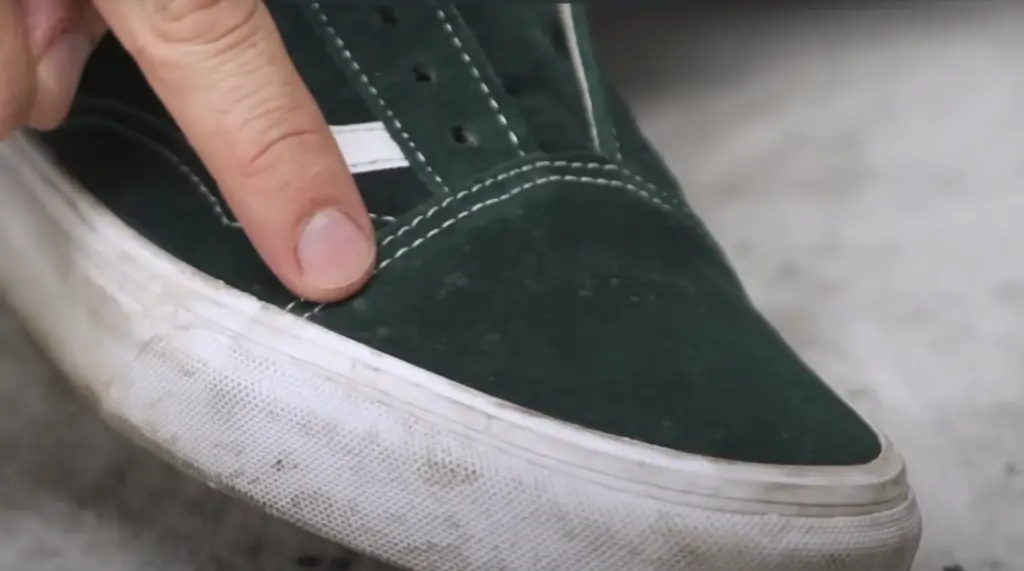
While suede is often associated with winter weather garments like gloves and coats, the truth is that it can be worn all year round. However, one question that often comes up is whether or not suede can get wet.
The answer is quite straightforward: no, you should not get suede wet. Water can damage the material, causing it to stain, discolor, or become misshapen. In addition, water can also cause the leather to dry out, making it more susceptible to cracking and peeling. [1]
How Water Can Damage Suede Leather?
So now that we know that getting suede wet isn’t the best idea, what happens if you do get it wet? As mentioned before, water can cause irreparable damage to suede leather. Let’s discuss how water damages suede.
Ruined fibers
Exposing suede to water will cause the fibers to swell. As the fibers swell, they will begin to break and unravel. Once the fibers start breaking, there is no way to repair them completely. The damage is permanent and your suede item will never look the same.
Fibers of suede are different from the fibers of other types of leather. The suede is made from the underside of the skin, which is why it has a unique nap. The fibers are shorter and not as tightly woven together as they are in other types of leather. This makes them more susceptible to damage from water.
Discoloration
Water can also cause suede to discolor. When suede gets wet, the dye in the leather can bleed and transfer to other surfaces. This can ruin your suede item and any other items it comes into contact with.
Suede is also more likely to stain than other types of leather. If you get something like mud or dirt on your suede, it will be very difficult to remove. And if you do manage to remove the stain, it is likely that the suede will be discolored in that area.
Mold and mildew
If suede gets wet and is not allowed to dry properly, it can develop mold and mildew. Mold and mildew are fungi that grow in damp, dark environments. They can cause serious damage to your suede item and are very difficult to remove.
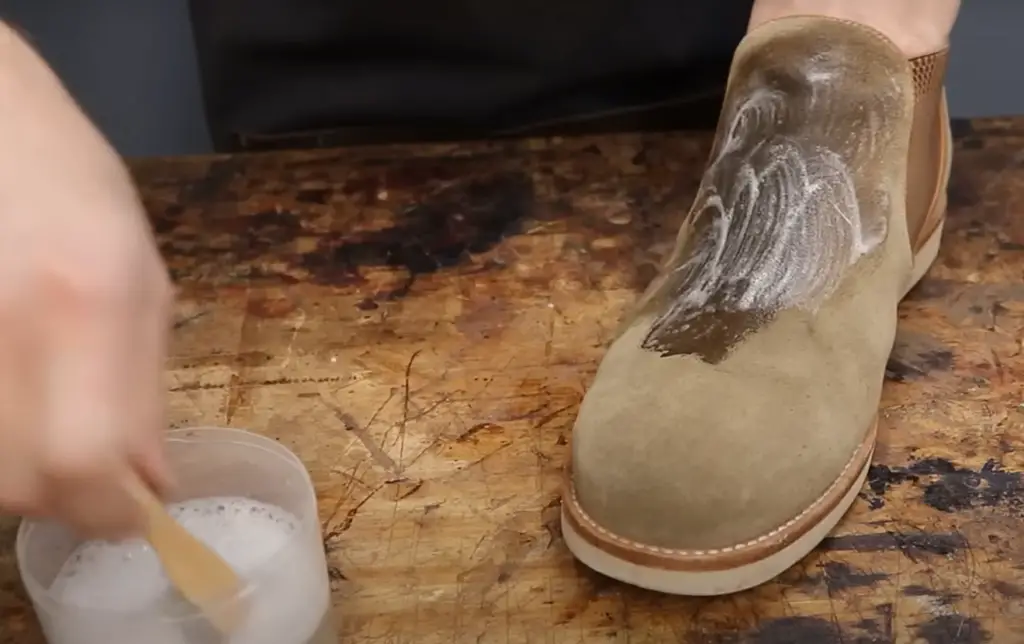
Mold and mildew will not only ruin the appearance of your suede, but they can also make it smell musty. If you notice any mold or mildew on your suede, it is best to throw it away immediately.
Loss of shape
Suede is a very delicate material and it can lose its shape if it gets wet. If you have a suede item that is dry-cleaned only, you may notice that it looks different after it has been cleaned. This is because the water can cause the fibers to swell and change shape.
Once the shape of your suede item has been altered, there is no way to change it back. The only way to fix this problem is to replace the item entirely. [1]
How to Protect Your Suede Leather?
Now that we know all the ways that water can damage suede, let’s discuss how you can protect your suede items from water damage or any damage in general. After all, suede is a delicate material, and you want to do everything you can to keep it looking its best.
Store your suede items properly
Avoid storing your suede items in plastic bags, as this can cause the leather to dry out and crack. It’s also worth it to check on humidity and temperature levels in your home, as extreme changes in either can damage the suede. Suede is a natural material, and it is sensitive to its environment.
Wipe spills right away
The most important rule of suede care is to never let a spill sit. No matter what the substance is, it’s important to act fast. The longer a spill sits on suede, the more time it has to soak in and cause damage. So, if you spill something on your suede shoes or jacket, be sure to grab a clean cloth and start wiping it up immediately.
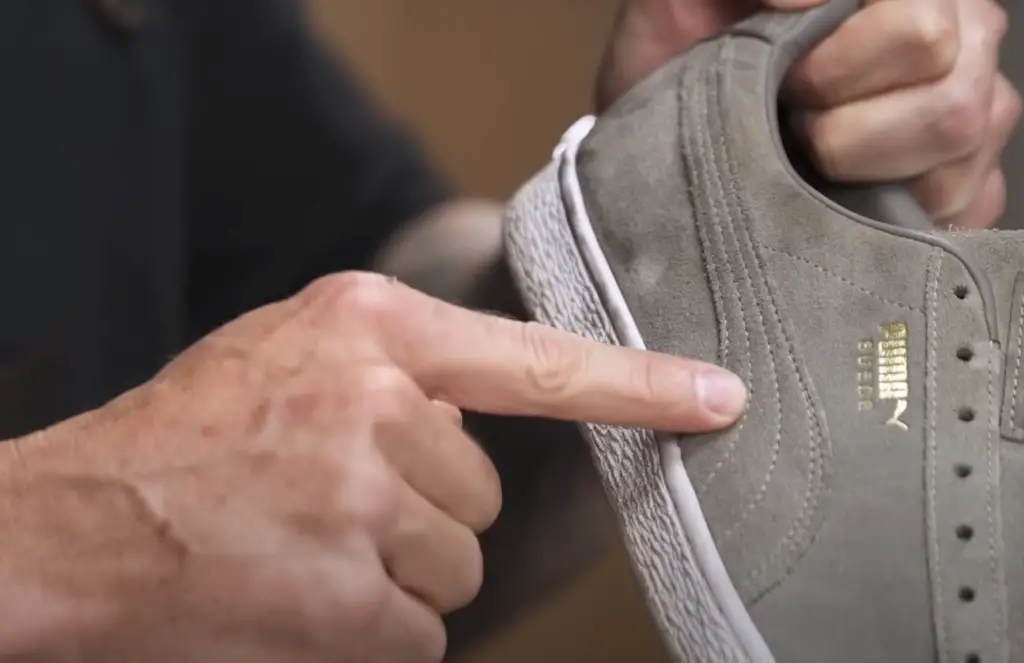
Professionally clean your suede items at least once a year
If you have a lot of suede items, or if you wear them often, you should consider professional cleaning them at least once a year. This will help to remove any dirt, grime, or stains that may have built up over time. A professional cleaner will also be able to treat any areas that are particularly susceptible to water damage, such as the seams or the soles of shoes.
Waterproof your suede items
If you live in an area with lots of rain or snow, you may want to waterproof your suede items. Waterproofing will help to repel water and stains from your suede, and it can also help to extend the life of your suede items.
There are a few different ways you can waterproof your suede. But the best way is to use a compatible waterproof spray, such as Scotchgard or Nikwax Fabric & Leather Proof.
Just make sure the product you use is designed for waterproofing suede, as some products can actually damage the material.
Avoid wearing suede items in wet weather
Obviously, the best way to protect your suede from water damage is to avoid wearing it in wet weather altogether. If you know you’re going to be outside in the rain or snow, leave your suede items at home.
So, if you live in a particularly humid climate, or if you’re traveling to a humid destination, it’s best to err on the side of caution and leave your suede items at home.
Clean your suede regularly
Of course, one of the best ways to protect your suede is to keep it clean. Suede is a magnet for dirt, dust, and debris, so it’s important to brush it regularly with a soft-bristled brush. You can also use a lint roller to remove any smaller particles.
Don’t use harsh chemicals or abrasive cleaners on your suede, as this will damage the material. Instead, opt for mild soap or saddle soap. And avoid applying too much pressure when you’re cleaning, as this can also damage the suede. [1] [2] [3]
How to Treat Water Damage on Suede Leather?
Unfortunately, even if you take all the necessary precautions, your suede leather may still become wet. Whether it’s from rain, snow, or a spill, water damage is one of the most common problems with suede. The good news is that usually, water damage is usually not permanent. With a little time and effort, you can often restore your suede leather to its original condition. In this section, we’ll cover some of the best ways to treat water damage on suede leather.
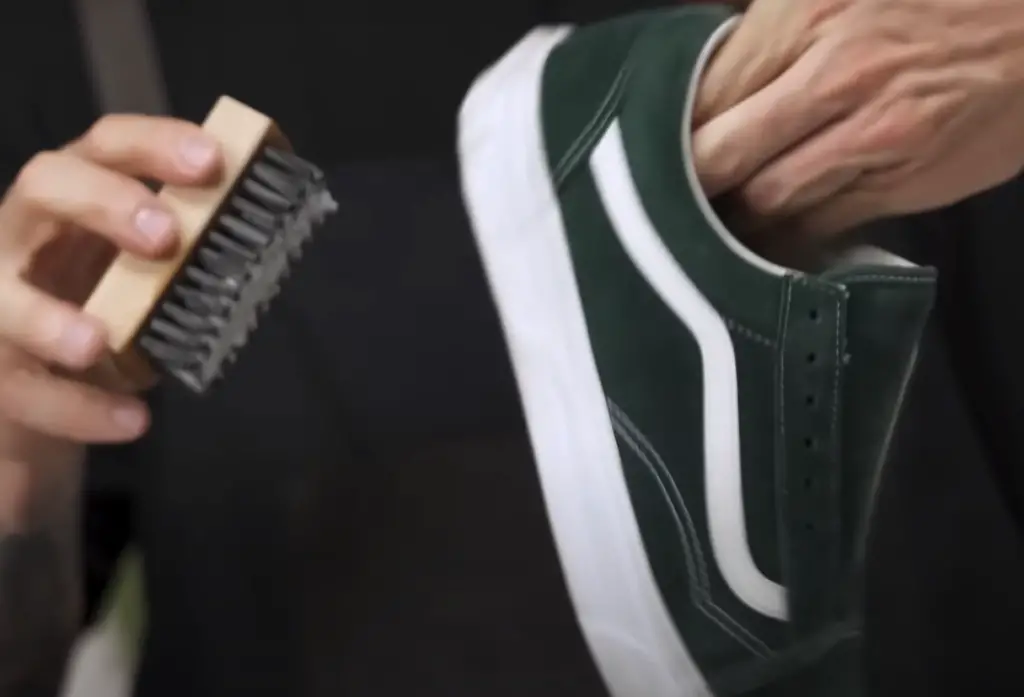
Stuff the shoes with newspaper
If your shoes have been soaked through, the first thing you’ll want to do is stuff them with newspaper. This will help to absorb some of the water and prevent the suede leather from warping. Once the shoes are stuffed, you’ll want to place them in a well-ventilated area so they can dry naturally. Avoid placing them near heaters or in direct sunlight, as this could cause the suede leather to shrink or warp.
Clean dirt and grime with a soft brush
Once your shoes are dry, you’ll want to brush off any dirt or grime that may have been left behind by the water. Use a soft-bristled brush or a suede eraser to gently remove any dirt or stains. Make sure to brush in the direction of the grain to avoid damaging the suede leather.
Apply talcum powder
One popular method is to apply talcum powder to the water stains. The talcum powder will help to absorb the water and should help to disguise the stains. Simply apply a small amount of talcum powder to the water stains and allow it to sit for a few minutes. Once the talcum powder has had time to work, you can brush it away with a soft-bristled brush.
Blot the wet spots
If there are any fresh wet spots remaining on your suede leather, you’ll want to blot them with a clean cloth. Avoid rubbing the wet spots, as this could cause the suede leather to become damaged. Once you’ve blotted the wet spots, you’ll want to allow the suede leather to air dry completely.
Remove the excess water with a towel
If your shoes are damp after cleaning, you will need to remove the excess water with a towel. Gently squeeze the towel to remove as much water as possible. Avoid wringing the towel, as this could cause the suede leather to become damaged. Once you’ve removed the excess water, you’ll want to allow the suede leather to air dry completely.
Dry your leather products carefully
While you might be tempted to throw your leather goods in the dryer, it’s important to air dry them instead. The heat from a clothes dryer can cause the leather to shrink or warp. For this reason, we can’t recommend hair dryers either, even in a cool setting.
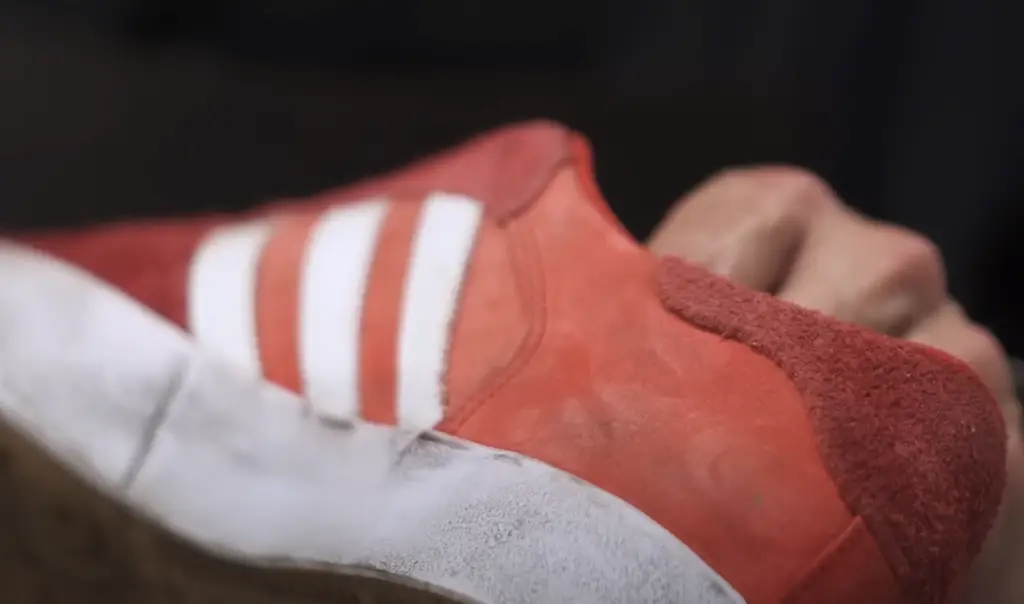
Spruce up the fibers to return them to normal
Once your suede leather is dry, you may notice that the fibers are looking a little flat. This is normal and can be easily fixed with a soft-bristled brush. Simply brush the fibers in the direction of the grain to return them to their original state. Just be careful not to over-brush, as this could damage the suede leather.
Sadly, there’s little that can be done once the wet spots dry and leave behind water stains. However, there are a few things you can try to help disguise the water stains.
Use a white vinegar
While this method isn’t guaranteed to work, it’s worth a try if you’re desperate. Simply dip a clean cloth into the white vinegar and use it to blot the water stains. The vinegar will help to break down the water and should help to remove the stains. Once you’ve treated the stains, you’ll want to allow the suede leather to air dry completely.
Blot the rest of the surface to even the color
If nothing helped to remove the water stains, you can try to disguise them with a bit of color. Simply take a clean cloth and dampen it with water. Once the cloth is damp, you’ll want to use it to blot the entire surface of the suede leather. This will help to even out the color and should help to camouflage the water stains. Just be sure to allow the suede leather to air dry completely before wearing or using it.
We understand not everyone is comfortable getting their suede leather wet. If you’re one of those people, there are still a few options for cleaning your suede leather. [1] [2] [3]
Can Suede Get Wet? Understanding Suede’s Vulnerability to Moisture
Suede is known for its soft and luxurious texture, but it’s also notorious for being vulnerable to moisture. In the table below, we’ll explore how suede reacts to wet conditions and offer some guidance on its care.
| Aspect | Suede |
|---|---|
| Material | A type of leather with a napped finish |
| Reaction to Water | Highly susceptible to water damage |
| Stains and Spots | Water can leave permanent stains and spots |
| Drying | Should be dried slowly at room temperature; avoid direct heat |
| Prevention | Use waterproofing sprays and avoid wearing suede in wet conditions |
Explanation of the Table:
- Aspect: Lists key aspects related to how suede reacts to water.
- Suede: Describes suede’s characteristics and its reaction to moisture.
Suede is highly susceptible to water damage because of its napped surface, which readily absorbs moisture. When suede gets wet, it can leave permanent stains and spots that are challenging to remove. If your suede item gets wet, it should be dried slowly at room temperature; avoid using direct heat sources like hair dryers or radiators, as they can cause the suede to become stiff or crack.
Preventing suede from getting wet is the best approach. You can use waterproofing sprays specifically designed for suede to add a protective layer that repels water. Additionally, it’s wise to avoid wearing suede items in wet conditions to maintain their appearance and longevity.
Remember that proper care and prevention are essential to keep your suede items looking their best and to minimize the risk of water damage.
FAQ:
Is suede durable leather?
Suede is a type of leather with a napped finish, meaning that the surface has been buffed or sanded to create a soft, velvety nap. It’s often used for clothing and furniture upholstery, as well as shoes, gloves, and other accessories.
While suede is generally more delicate than other types of leather, it can be quite durable if properly cared for. However, because of its unique finish, it is more susceptible to staining and water damage than other materials.
What is the best waterproofing treatment for suede

Will suede ruin if it gets wet?
One huge downside to suede is that it can be easily damaged if it gets wet. Water can cause the fibers to swell and change color, and once wet, suede can be difficult to dry without causing further damage. And the famous soft fibers that give the material its unique texture can become matted and brittle when wet, making it more susceptible to tearing.
So to avoid such disasters, it’s important to take extra care of your suede goods when the weather is less than ideal. Avoid wearing them in the rain or snow, and if you do get them wet, be sure to treat them as quickly as possible.
What to do after getting suede wet?
As you can see, getting suede wet isn’t the end of the world. By taking proper care of your suede items and following these simple tips, you can keep them looking great for years to come.
Can a suede jacket get wet?
Suede is a very delicate material, and as such, it is not recommended that you get it wet. However, if you do get your suede jacket wet, there are a few things you can do to try and salvage it.
First, you will want to remove any excess water from the jacket as soon as possible. Use a clean, soft cloth to blot the wet areas and absorb as much moisture as possible. Do not rub the cloth over the suede, as this will only damage the material further.
Once you have removed as much water as possible, allow the jacket to air dry in a cool, well-ventilated area. Do not put it in direct sunlight or heat, as this will cause the suede to shrink and warp.
We also suggest you apply a waterproofing spray to your jacket before wearing it in inclement weather. This will help to repel water and protect the suede from damage.
How long does it take suede to dry?
How long it will take for your suede to dry depends on a number of factors, such as the type of suede, the weather, and how wet the suede got in the first place. Suede is a natural material made from animal skin, so it’s important to treat it with care.
If you’re caught in the rain or your suede shoes get splashed by a puddle, the first thing you should do is remove any excess water with a soft cloth. Once you’ve done that, you need to let the suede air dry. This can take up to a day, depending on the conditions.
In general, it’s best to avoid getting suede wet if possible. However, if it does get wet, follow the steps above and be patient while it dries. With proper care, your suede should eventually return to its original condition.
Is suede naturally water-resistant?
Suede is not naturally water-resistant. It is made from the underside of animal hides and is more susceptible to water damage compared to full-grain leather.
Can suede shoes be worn in the rain?
It’s not advisable to wear suede shoes in heavy rain, as prolonged exposure to water can damage suede and cause stains. If caught in the rain, allow them to air dry naturally.
Can suede be waterproofed?
Yes, suede can be waterproofed using specialized suede protectant sprays. These products create a barrier that repels water and helps prevent stains. Regular reapplication may be necessary.
What happens if suede gets wet?
When suede gets wet, it can lose its soft texture and develop water stains. It’s crucial to let wet suede dry naturally and avoid heat sources like hairdryers, as they can further damage the material.
Can you wear suede in snowy conditions?
Suede is not suitable for snowy conditions as snow and slush can saturate the material, leading to damage and staining. Opt for more weather-resistant footwear in such conditions.
Is there a way to remove water stains from suede?
Water stains on suede can be challenging to remove. You can try using a suede brush or eraser to gently rub the stained area. If the stain persists, consult a professional suede cleaner.
Can suede be machine-washed?
No, suede should never be machine-washed. This can severely damage the material. Instead, follow specific care instructions for suede items, which often include gentle brushing and spot cleaning.
Can suede be restored after getting wet?
While suede can be restored to some extent after getting wet, it may not return to its original condition. Consulting a professional cleaner or using specialized suede restoration products can help.
Can suede be used for outdoor furniture?
Using suede for outdoor furniture is not recommended, as it is not designed to withstand exposure to the elements. Choose outdoor-friendly materials for such purposes.
Can suede be used for hiking boots?
Suede is not the ideal material for hiking boots, as it’s not as durable or water-resistant as full-grain leather or synthetic options. Choose footwear specifically designed for hiking.
Useful Video: How To Clean Your Suede Sneakers
Conclusion
A suede is a material made from the underside of an animal’s skin, usually a deer. It is characterized by its softness, napped finish, and unique grain. Suede is used in garments, upholstery, shoes, and other products.
While suede is often associated with high-end luxury goods, it is actually a fairly delicate material. When it gets wet, suede can shrink, stain, and lose its shape. As a result, many people are hesitant to wear or use suede products for fear of ruining them.
So, can you get suede wet? The answer is no. Water can damage suede, causing it to shrink, stain, and lose its shape. If your suede leather gets wet, the first thing you should do is blot the area with a clean, dry cloth. Do not rub the wet area, as this will only spread the water and make the stain larger. Once you’ve blotted the area, let it air dry naturally. Avoid using a hair dryer or other heat source, as this can cause the suede to shrink or wrinkle. If the stain is still visible after the area has dried, you may need to use vinegar to remove it. Thanks for reading! I hope this article was helpful.
References:
- https://homeexplained.com/will-suede-ruin-if-it-gets-wet/
- https://www.wikihow.com/Protect-Suede-Boots
- https://www.leatherskill.com/how-to-repair-water-damaged-leather/

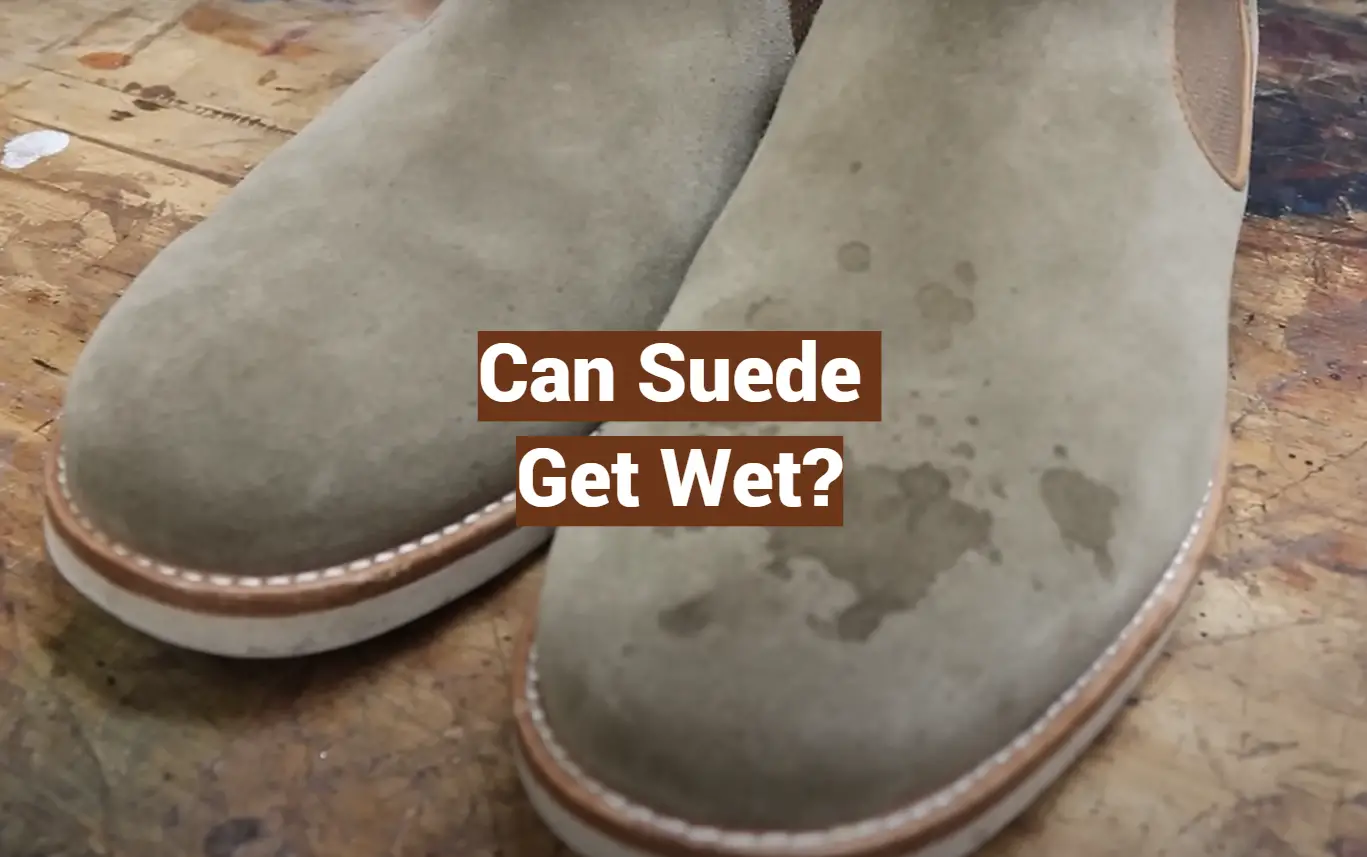





Leave a Reply